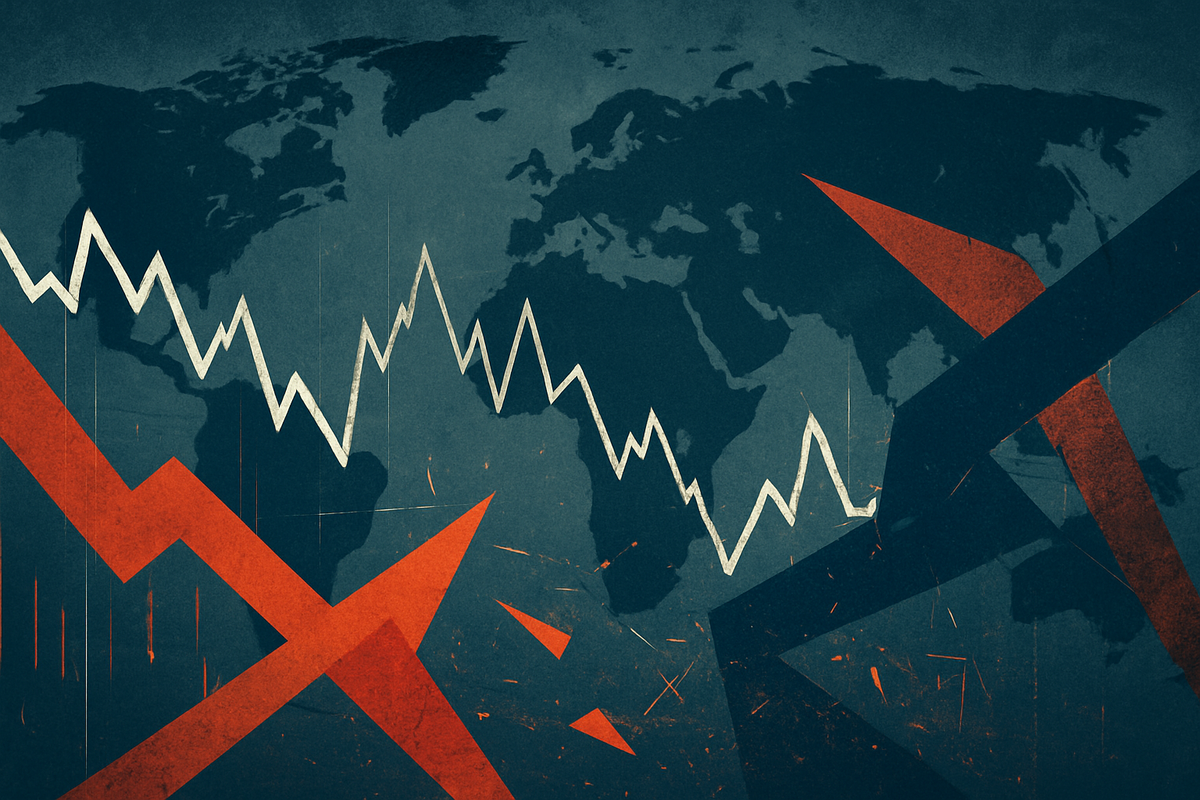
The global economic landscape as of November 2025 is marked by a pervasive sense of uncertainty, with stock market stability continually tested by a confluence of persistent inflation, cautious monetary policy, and an increasingly volatile geopolitical environment. Investors and analysts alike are grappling with subdued growth projections, with the World Bank forecasting a global growth rate of 2.3% for 2025, the slowest since the 2008 financial crisis outside of global recessions. This deceleration, coupled with inflation that remains stubbornly above target in key economies like the United States and the United Kingdom, creates a challenging backdrop for financial markets.
Adding layers of complexity, a series of significant geopolitical events are directly impacting market sentiment and performance. From the ongoing Russia-Ukraine war and escalating tensions in the Middle East to the persistent US-China trade rivalry and even domestic political instability within the United States, these events are fueling elevated volatility, prompting risk aversion, and disrupting critical supply chains. The immediate implications include rapid shifts in market sentiment, sector-specific vulnerabilities, and a complicated path forward for central banks attempting to balance inflation control with economic growth.
Geopolitical Crossroads: A Deep Dive into Market-Shaping Events
The current global market instability is not a singular phenomenon but rather a complex tapestry woven from several interconnected geopolitical threads, each with its own timeline, key players, and significant market repercussions. As of November 2025, these events continue to unfold, demanding constant vigilance from investors.
The Russia-Ukraine War, now in its extended phase, remains a primary driver of uncertainty. While initial market shocks were absorbed, the conflict continues to exert upward pressure on energy prices and disrupt the supply of vital commodities such as wheat and corn. The timeline has seen intermittent peace talks collapse, maintaining a state of prolonged conflict that fuels market volatility and increases the probability of slower global growth. Key players include Russia, Ukraine, and their respective international allies, with the energy sector and commodity traders being particularly sensitive to developments. Initial market reactions included sharp spikes in oil and gas prices (NYMEX: CL=F, ICE: BZ=F) and agricultural futures, followed by sustained elevated levels.
Simultaneously, Middle East Tensions, particularly involving Israel, Hamas, and the broader regional influence of Iran, pose an existential threat to global economic stability. The timeline has been characterized by cycles of escalation and de-escalation throughout 2025, with any significant flare-up having the potential to severely disrupt global oil supplies, pushing prices well above $100 per barrel and triggering widespread inflationary pressures. The Strait of Hormuz, a critical chokepoint for oil shipments, remains a focal point of concern. This environment fosters heightened risk aversion, impacting equity performance globally and driving demand for safe-haven assets such as gold (COMEX: GC=F) and the US dollar (ICE: DXY).
The US-China Trade and Technology Rivalry continues to evolve, marked by a fluctuating landscape of tariffs, export controls, and intermittent truces. While a temporary agreement on tariffs was reached in October 2025, the underlying strategic competition, particularly in critical technologies like semiconductors, persists. This rivalry involves the US government, the Chinese government, and major multinational corporations like Taiwan Semiconductor Manufacturing Company (NYSE: TSM) and Intel Corporation (NASDAQ: INTC). The timeline has seen ongoing policy announcements and counter-announcements, creating significant uncertainty for global supply chains and affecting sourcing patterns and costs for numerous industries.
Domestically, the US Political Instability, specifically an ongoing federal government shutdown as of November 2025, adds another layer of anxiety. This event, involving the US Congress and the Executive Branch, has led to corporate layoffs, a halt in the release of critical economic data, and disruptions to essential services. Such internal geopolitical events create systemic operational risks and exacerbate economic uncertainties for global investors, influencing market sentiment and potentially affecting the credit rating of the US. Furthermore, the prospect of a returning Donald Trump to the White House introduces significant policy uncertainty regarding future tax cuts and tariffs, which could reshape the global trading environment.
Collectively, these events foster an environment of elevated volatility, leading to rapid shifts in investor sentiment and a noticeable lean towards risk-off behavior. The CBOE Volatility Index (CBOE: VIX) has seen sustained higher levels, reflecting the market's apprehension. Investors are increasingly seeking defensive assets, and sectors tied to global trade and supply chains face ongoing challenges, while those in defense or domestic infrastructure may see opportunities.
Corporate Fortunes in a Fractured World
The current geopolitical and economic climate is creating distinct winners and losers among public companies, forcing strategic pivots and re-evaluations across various sectors. The impact is felt through supply chain disruptions, shifts in consumer demand, regulatory changes, and direct exposure to conflict zones.
Companies deeply integrated into global supply chains, particularly those reliant on components or raw materials from regions affected by trade tensions or conflicts, face significant headwinds. For instance, Apple Inc. (NASDAQ: AAPL) and other consumer electronics manufacturers are continually navigating the complexities of the US-China trade rivalry, which impacts sourcing, manufacturing costs, and market access. Any escalation in tariffs or export controls could force expensive re-shoring or diversification of production, affecting profitability and potentially leading to higher consumer prices. Similarly, automotive giants like Toyota Motor Corporation (NYSE: TM) and General Motors Company (NYSE: GM) are vulnerable to disruptions in the supply of critical components, such as semiconductors, exacerbated by geopolitical tensions.
The energy sector, while benefiting from price spikes, also faces extreme volatility. Oil and gas producers like Exxon Mobil Corporation (NYSE: XOM) and Chevron Corporation (NYSE: CVX) have seen increased revenues due to higher crude prices stemming from the Russia-Ukraine war and Middle East tensions. However, this comes with increased regulatory scrutiny and the risk of demand destruction if prices become unsustainable. Renewable energy companies, such as NextEra Energy, Inc. (NYSE: NEE), might see increased investment as nations seek energy independence, but they too are subject to supply chain issues for critical materials.
Defense contractors are clear beneficiaries of heightened global instability. Companies like Lockheed Martin Corporation (NYSE: LMT) and Raytheon Technologies Corporation (NYSE: RTX) are experiencing increased demand for their products and services as nations ramp up defense spending in response to perceived threats. The prolonged conflicts and rising geopolitical risks translate directly into larger order backlogs and robust revenue growth for these firms.
Conversely, companies heavily reliant on international trade and stable global relations, particularly those in logistics and shipping, such as A.P. Møller-Mærsk A/S (CPH: MAERSK-B) or FedEx Corporation (NYSE: FDX), face increased costs and operational challenges due to disruptions like the Red Sea crisis. Extended shipping times and higher insurance premiums eat into profit margins and can lead to delivery delays, impacting customer satisfaction and market share. Airlines, like United Airlines Holdings, Inc. (NASDAQ: UAL), are also sensitive to rising fuel costs and potential restrictions on airspace due to conflicts.
The technology sector presents a mixed bag. While some semiconductor companies face vulnerabilities due to US-China tensions, those focused on artificial intelligence (AI) infrastructure, such as NVIDIA Corporation (NASDAQ: NVDA), could see continued upside if trade relations stabilize and global investment in AI accelerates. However, these companies are not immune to potential export controls or intellectual property disputes. Financial institutions, including JPMorgan Chase & Co. (NYSE: JPM) and Bank of America Corporation (NYSE: BAC), navigate increased regulatory complexity and potential credit risks associated with slower global growth and economic instability in various regions.
Broader Implications and Historical Parallels
The current confluence of geopolitical events and economic challenges is not merely a series of isolated incidents but rather reflects deeper, evolving trends with significant wider implications for global industries, regulatory frameworks, and international relations. This period marks a potential inflection point, reshaping global supply chains, trade policies, and investment strategies for years to come.
One of the most profound broader industry trends is the accelerated move towards de-globalization or "friend-shoring." Companies are increasingly re-evaluating their supply chains, seeking to reduce reliance on single points of failure or politically sensitive regions. This often means diversifying manufacturing bases or bringing production closer to home, even if it entails higher costs. This trend has significant ripple effects on competitors and partners; for example, a company moving production out of China might create opportunities for manufacturers in Vietnam or Mexico, while simultaneously impacting its Chinese partners. This strategic shift is evident in sectors ranging from electronics to pharmaceuticals, where resilience is prioritized over pure cost efficiency.
Regulatory and policy implications are also immense. Governments are increasingly using trade policy as a tool of national security, leading to a proliferation of export controls, sanctions, and tariffs. The US-China rivalry, in particular, has prompted both nations to implement policies aimed at protecting domestic industries and technological leadership. This creates a complex regulatory environment that multinational corporations must navigate, often requiring significant legal and compliance resources. The ongoing federal government shutdown in the US, while domestic, underscores the fragility of policy stability and its direct impact on business operations and investor confidence.
Historically, periods of significant geopolitical upheaval have often led to fundamental shifts in the global economic order. Comparisons can be drawn to the Cold War era, where ideological competition shaped trade blocs and technological development, or the oil crises of the 1970s, which forced a global re-evaluation of energy policies. During these times, markets experienced prolonged periods of volatility, and specific industries either thrived or suffered based on their alignment with prevailing geopolitical currents. For instance, the post-World War II era saw the rise of new global institutions and a period of sustained economic growth, albeit with underlying geopolitical tensions. The current environment, with its multi-polar power dynamics and complex interdependencies, presents unique challenges, suggesting that historical precedents offer guidance but not a perfect roadmap.
The potential for ripple effects on competitors and partners is substantial. A company's decision to exit a market due to political risk could create a vacuum that competitors quickly fill, or it could disrupt an entire ecosystem of suppliers and distributors. Furthermore, the fragmentation of global trade and technology standards could lead to less efficient markets and higher costs for consumers worldwide. The strategic decoupling in critical sectors like semiconductors, for example, could force companies to develop distinct product lines for different geopolitical blocs, increasing R&D costs and limiting economies of scale.
What Comes Next: Navigating the Uncertain Horizon
Looking ahead, the global economic and geopolitical landscape presents a spectrum of short-term and long-term possibilities, demanding strategic agility and foresight from businesses and investors alike. The trajectory of current events suggests a continued period of elevated uncertainty, but also potential areas for adaptation and opportunity.
In the short term, the immediate focus will remain on the de-escalation of existing conflicts and the resolution of political impasses. A cessation of hostilities in Ukraine or a significant diplomatic breakthrough in the Middle East could provide a much-needed boost to market sentiment, potentially leading to a rebound in risk assets and a softening of commodity prices. Conversely, any escalation could trigger further market sell-offs and exacerbate inflationary pressures. The resolution of the US federal government shutdown is critical for restoring domestic economic stability and confidence. Companies will likely prioritize strengthening balance sheets, optimizing working capital, and ensuring robust contingency plans for supply chain disruptions.
Long-term possibilities point towards a more fragmented global economy, characterized by regional trade blocs and diversified supply chains. This "de-risking" strategy, while potentially more expensive, aims to build resilience against future geopolitical shocks. Companies may increasingly invest in automation and localized production to reduce reliance on international labor and complex logistics. This could lead to a re-industrialization in some developed economies and a shift in manufacturing hubs towards politically stable regions. The push for energy independence, fueled by ongoing energy market volatility, will likely accelerate investments in renewable energy sources and related infrastructure.
Potential strategic pivots or adaptations required will be multifaceted. Businesses will need to become adept at scenario planning, stress-testing their operations against various geopolitical outcomes. This includes developing flexible sourcing strategies, investing in cybersecurity to protect against state-sponsored attacks, and fostering strong government relations to navigate complex regulatory environments. For technology companies, this might mean designing products with dual-use capabilities or establishing independent R&D centers in different regions. Financial institutions will need to enhance their risk management frameworks to account for increased geopolitical risk, currency volatility, and potential sovereign debt crises.
Market opportunities or challenges that may emerge are diverse. Sectors poised for growth include defense, cybersecurity, renewable energy, and critical infrastructure development. Companies specializing in supply chain resilience, logistics optimization, and advanced manufacturing technologies will also find increased demand for their services. However, traditional globalized sectors, suchs as international tourism or certain export-oriented manufacturing, may face ongoing challenges. Emerging markets, particularly those with stable political environments and abundant resources, could attract increased foreign direct investment as companies seek to diversify their global footprint.
Potential scenarios and outcomes range from a "soft landing" where central banks successfully tame inflation without triggering a deep recession, to a more challenging "stagflationary" environment marked by persistent inflation and stagnant growth. A worst-case scenario involves a significant escalation of a major conflict, leading to widespread supply chain paralysis, hyperinflation, and a severe global recession. Conversely, a coordinated global effort towards diplomatic resolutions and economic cooperation could pave the way for a more stable and prosperous future, though this appears less likely in the immediate term given current trajectories.
Comprehensive Wrap-up: Navigating a New Era of Market Dynamics
The current global economic outlook, heavily influenced by a tumultuous geopolitical landscape, underscores a fundamental shift in market dynamics. The era of predictable globalization and relatively stable international relations appears to be giving way to a more fragmented and volatile environment, demanding a recalibration of investment strategies and corporate operations.
The key takeaways from this period are clear: geopolitical risk is no longer a peripheral concern but a central driver of market performance. Persistent inflation, coupled with cautious monetary policies, creates a delicate balance for central banks, while conflicts in Ukraine and the Middle East, along with the US-China rivalry, inject profound uncertainty into energy markets, supply chains, and technology sectors. The ongoing US federal government shutdown further highlights the vulnerability of markets to domestic political instability.
Moving forward, the market is likely to remain characterized by elevated volatility and a continued tilt towards risk aversion. Investors will increasingly prioritize resilience and stability, favoring companies with strong balance sheets, diversified operations, and exposure to defensive sectors. The premium on geopolitical intelligence and scenario planning will grow, as rapid shifts in the global political arena can have immediate and significant financial repercussions.
Final thoughts on significance and lasting impact suggest that this period could fundamentally reshape global trade, investment patterns, and international cooperation. The push for supply chain diversification, energy independence, and technological sovereignty will have enduring effects on industrial structures and national economic policies. The current challenges are not merely cyclical but indicative of deeper structural changes in the global order.
What investors should watch for in coming months includes any signs of de-escalation in major geopolitical conflicts, as these could trigger significant market rallies. Key economic indicators, particularly inflation data and central bank policy statements, will continue to be crucial for understanding the trajectory of interest rates and economic growth. Furthermore, developments in US-China trade relations and the resolution of the US government shutdown will provide critical signals regarding policy stability and market confidence. Investors should also closely monitor corporate earnings reports for insights into how companies are adapting to these new global realities, paying particular attention to those demonstrating resilience and strategic foresight in navigating a world increasingly defined by geopolitical crosscurrents.
This content is intended for informational purposes only and is not financial advice






